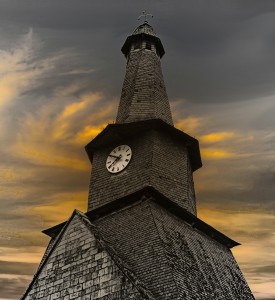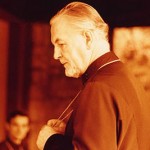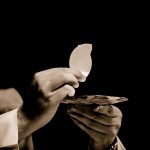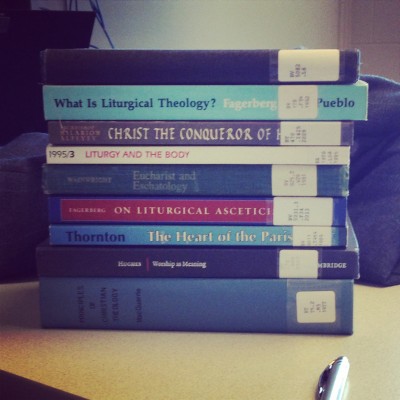Several weeks ago, I was privileged to contribute a piece as a guest to the Covenant blog of The Living Church. Many thanks to the blog’s managing editor, Zachary Guiliano for publishing this piece on the liturgical nature of time. You can read this article below or in its original format here.
This post really covers two different topics. First, how does the Church tell time daily, weekly, and annually? This much should be obvious. Second, and perhaps more importantly, how does the incarnation, life, ministry, crucifixion, resurrection, and exaltation of Jesus the Christ influence our understanding of time? Further, is liturgical time real time?
It is safe to say — and perhaps overly apparent — that the Church tells time differently than the rest of the world. Rather than marking time by the seasons, political and military holidays, or the movement of plants and stars named after Roman gods, the Church tells time according to Jesus of Nazareth. Beginning with the first Sunday in Advent as we await the birth of the boy who is King, and ending with Christ the King Sunday, every aspect of the Church’s life can be understood within the context of Jesus’ own story.
Annually
As such, the new year is not the first of January but the first Sunday of Advent; the highest and holiest day of the year is not the fourth of July (America) or even Christmas (Hallmark) but the annual celebration of the Paschal Mystery: Easter. The feasts and the fasts of the Church help us to remember the saints and exemplars who have gone before, those who have embodied the way of Christ tangibly among us. The year then flows accordingly: Advent for the first coming of the Messiah, Christmastide as we celebrate his birth, Epiphany as we embrace the manifestation of God in Christ, Lent to recount the temptation of the Lord as we prepare for Holy Week and Easter, Holy Week as we journey through Jesus’ last days on earth, Easter for the church’s celebration par excellence, Eastertide as a reminder of Jesus’ post-resurrection and pre-exaltation days, Pentecost to remember the gift of the Holy Spirit, Ordinary Time as a corporate journey through Israel’s history and the teachings of our Lord, and finally Christ the King Sunday as we once again proclaim his kingship.
Such an annual cycle has a profound influence theologically and within the constructs of Christian formation. This is a time that is other than the time of the world, it is counter to the story and narratives of the powers and principalities that be, it is in short real time.
Weekly
The same is true of our week. We mark our week around one day: Sunday. Sunday is the first, the third, and the eighth day of the week. This is bizarre; it sounds as confusing as attempting to explain the Trinity, but it is nonetheless true.
Sunday is the first day of the week and the first day of creation. It is the day of the Sun of Righteousness, given that Saturday is the Sabbath, the day of rest. It is the third day,because it was on Sunday that our Lord was raised from the grave, having conquered sin, death, and the devil; having “trampled down death by death,” he was raised to new life, echoing his bold claim from earlier in John’s gospel, “I am the resurrection and the life.” Finally, Sunday is the eighth day because the resurrection changes everything: it is the first day of the new week, the first day of the new creation. It is the breaking in of God’s Kingdom in the here and now. John marks his Gospel according to days, and the Sunday of the resurrection is both a continuation of the first day but also its fulfillment.
Nothing can ever be the same after the resurrection of Jesus, and time is no exception. Our week centers around the Church’s Sunday worship and celebration of the Eucharist — all other days gain their meaning in relation to this day.
Daily
Even our daily time is accounted differently. For those who follow the ancient tradition of the church time is marked by hours or offices of prayer. The Book of Common Prayer (1979) lists several such times: morning, noon, evening, and compline. Time then is measured by our ability to intercede and worship before the Lord, offering all that we are and all that we have to him, rather than by the workday or weekend schedule. The daily prayers coincide with both the Sunday Eucharist and the Church calendar, taking on new dimensions as we progress through the week and year. As we trek through the Psalter and the canon of Scripture, and as we sojourn together through the life of our Lord, our time is transformed into something different, something more, something almost whole.
Liturgical Time
What then do we do with liturgical time? It has often been said that as an individual steps into the nave for the liturgy “time ceases.” The indication here is that liturgical worship is somehow an escape or removal from time, that it is somehow against time as we know it. Not only do I find this unhelpful, I also find it untrue. Liturgical time is not the cessation of time; this could not be further from the truth. Liturgical time is in fact the thickening and deepening of time, it is time made more real; no, it is time made most real. Just as Jesus’ Kingdom is utterly for this world, so too is liturgical time absolutely for time as we know it in the Church.
The Sunday ordo celebrates the annual, weekly, and daily cycles of the Church’s prayer,and it proclaims, presents, and enacts the story of God in Christ. The dually climactic nature of Word and Table reaches a crescendo in the Eucharistic prayer when this sense of time is most fully revealed. The anamnesis is the reaching back into the past, dragging forward into the present, and making real of the sacrifice of Jesus. Similarly, we look forward to the day when God will be all in all; our eschatological hope gives us a foretaste of glory eternal and divine in the Eucharist. What we presently encounter is the crashing in of past and future into the now; it is the meeting of Christ’s salvific actions at the time of Passover and his coming again at time unknown. And yet we somehow experience it in a real, tangible, and robust sense on a weekly basis.
Liturgical time is thick. It is different. It is new. And it is utterly real. Our experience with and encounter of the living God through the sacrament of sacraments is the pinnacle of the Church’s worship. It is living with the reality, and in the light, of Jesus’ incarnation, crucifixion, resurrection, and exaltation as he reigns over all things. Our understanding of time is irrevocably and undeniably tied into the Paschal Mystery. We ought to be more intentional about telling time liturgically because to do so is to tell time according to Jesus rather than the competing and counterfeit narratives of this world.













